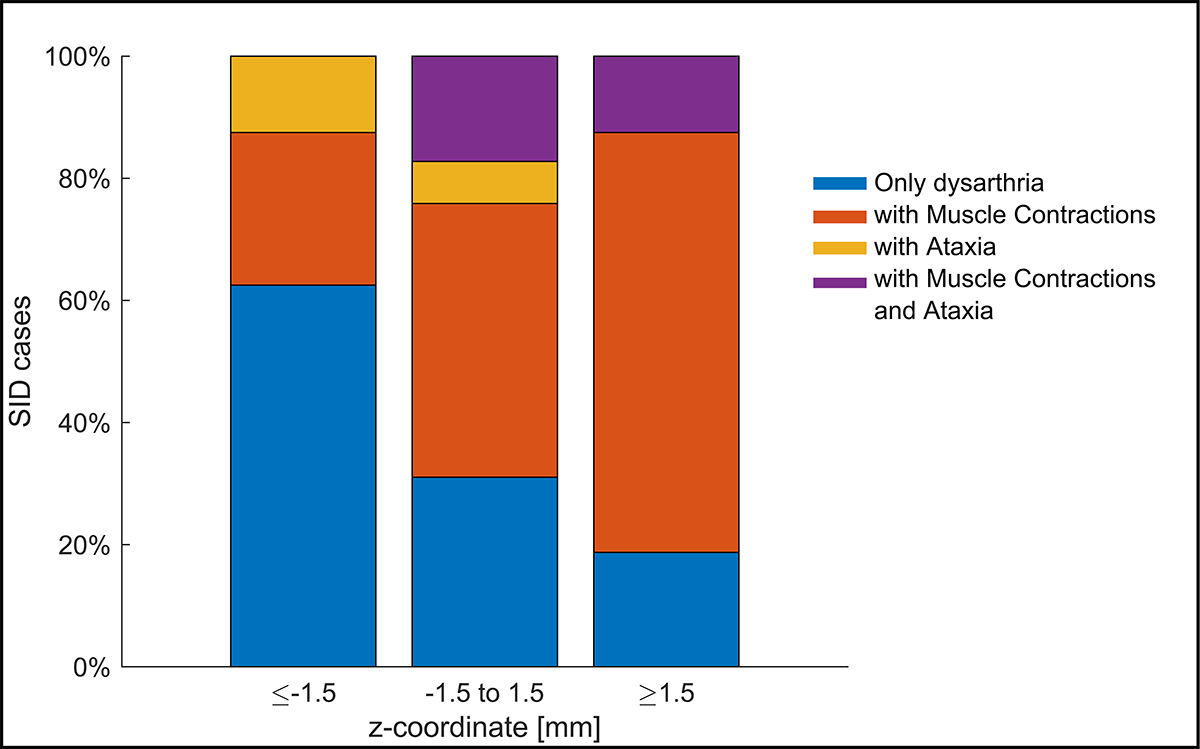Session Information
Date: Wednesday, September 25, 2019
Session Title: Surgical Therapy
Session Time: 1:15pm-2:45pm
Location: Les Muses Terrace, Level 3
Objective: To investigate the origin of stimulation-induced dysarthria (SID) in essential tremor (ET) patients with bilateral deep brain stimulation (DBS) in the ventral intermediate nucleus (VIM) or the posterior subthalamic area (PSA).
Background: SID is one of the most common side-effects of DBS in ET patients. Previous studies hypothesized that stimulation of corticobulbar or cerebellothalamic fibers might result in spastic or atactic deterioration of speech but to date the exact pathomechanisms remain unknown [1-3].
Method: Side-effect thresholds were determined in ET patients after bilateral DBS for all contacts in randomized order Speech analysis including oral diadochokinesis and reading of a standardized text were conducted without stimulation, at onset of SID, and with the maximum amplitude tolerated. DBS leads were reconstructed using the LEAD-DBS toolbox [4]. Thresholds of SID, spastic (muscle contractions), and atactic (ICARS item 10) side-effects at different electrode depths (z≤-1.5mm; -1.5>z<1.5mm, z≥1.5mm; all in relation to MCP) were analyzed, using linear mixed effect models.
Results: We included 14 ET patients (2 VIM, 12 VIM/PSA), resulting in 112 contacts analyzed. Thresholds for SID, spastic, and atactic side-effects increased from ventral to dorsal (p<0.05). The proportion of atactic symptoms associated with the onset of SID decreased from ventral to dorsal, while the proportion of spastic symptoms associated with the onset of SID increased from ventral to dorsal (Figure 1). Figure 1 – Symptoms associated with the onset of stimulation-induced dysarthria [figure1] Fig. 1: The proportion of ataxia associated with the onset of SID decreased from ventral to dorsal while the proportion of spastic side-effects increased.
Conclusion: Our preliminary results demonstrate, that SID often occurs in combination with spastic and/or atactic side-effects. The opposed ventrodorsal gradient for the proportion of atactic versus spastic symptoms associated with the onset of SID is in line with the anatomical course of cerebellothalamic and corticobulbar fibers. However, further investigations including detailed phonetic analysis and tractography is needed.
References: [1] Becker J, Barbe MT, Hartinger M, et al. The Effect of Uni- and Bilateral Thalamic Deep Brain Stimulation on Speech in Patients With Essential Tremor: Acoustics and Intelligibility. Neuromodulation 2017;20(3):223-232. [2] Fenoy AJ, McHenry MA, Schiess MC. Speech changes induced by deep brain stimulation of the subthalamic nucleus in Parkinson disease: involvement of the dentatorubrothalamic tract. J Neurosurg 2017;126(6):2017-2027. [3] Krack P, Batir A, Van Blercom N, et al. Five-year follow-up of bilateral stimulation of the subthalamic nucleus in advanced Parkinson’s disease. N Engl J Med 2003;349(20):1925-1934. [4] Horn A, Li N, Dembek TA, et al. Lead-DBS v2: Towards a comprehensive pipeline for deep brain stimulation imaging. Neuroimage 2018.
To cite this abstract in AMA style:
H. Jergas, J. Petry-Schmelzer, J. Becker, T. Thies, J. Steffen, V. Visser-Vandewalle, T. Dembek, M. Barbe. The origin of stimulation-induced dysarthria in ET patients after VIM/PSA-DBS: Atactic, spastic or both? [abstract]. Mov Disord. 2019; 34 (suppl 2). https://www.mdsabstracts.org/abstract/the-origin-of-stimulation-induced-dysarthria-in-et-patients-after-vim-psa-dbs-atactic-spastic-or-both/. Accessed December 5, 2025.« Back to 2019 International Congress
MDS Abstracts - https://www.mdsabstracts.org/abstract/the-origin-of-stimulation-induced-dysarthria-in-et-patients-after-vim-psa-dbs-atactic-spastic-or-both/

